Research on Overburdened Rock Structures and Support Resistance of Shallow Buried Large Mining Heights Based on Sheet Gangs
Abstract
1. Introduction
2. Top Plate Structure Under Coal Wall Sheet Ganging in Large Height Working Faces of Shallow Buried Coal Seams
Analysis of Direct Roof Structure Under Coal Wall Sheet Ganging in Large Height Working Faces of Shallow Buried Coal Seams
3. Calculation of the Support Resistance of a Large Height Sheet-Type Working Face Based on the “Step-Rock Beam” Structure
3.1. Single Key Layer Category 1 Direct Top
3.1.1. Determination of Working Face Support Resistance Under a Single Key Layer Type I Direct Roof Structure
3.1.2. Instance Validation
3.2. Single Key Layer Category 2 Direct Top
3.2.1. Determination of Working Face Support Resistance Under a Single Key Layer Type II Direct Roof Structure
3.2.2. Instance Validation
3.3. Double Key Layer Category 1 Direct Top
3.3.1. Determination of Working Face Support Resistance Under a Double Key Layer Type I Direct Roof Structure
3.3.2. Instance Validation
3.4. Double Key Layer Category 2 Direct Top
3.4.1. Determination of Working Face Support Resistance Under a Two-Critical Layer Type II Direct Roof Structure
3.4.2. Instance Validation
4. The Effect on Working Face Support Resistance Before and After Coal Wall Sheet Ganging
5. Conclusions
Author Contributions
Funding
Data Availability Statement
Conflicts of Interest
References
- Zeng, Q.; Ma, X.; Wan, L.; Zhu, Y.; Yue, Y. Research on the hydraulic support face guard mechanism and coupling charac teristic of rib spalling in large mining heights. Sci. Rep. 2024, 14, 8110. [Google Scholar]
- Li, G.; Li, Z.; Du, F.; Cao, Z. Mechanical mechanism of rib spalling and sensitivity analysis of gangue parameters to rib spalling in gangue-bearing coal seams. Environ. Sci. Pollut. Res. 2022, 30, 38713–38727. [Google Scholar] [CrossRef] [PubMed]
- Yin, X.W.; Yan, S.H.; An, Y. Characters of the rib spalling in fully mechanized caving face with great mining height. J. Min. Saf. Eng. 2008, 25, 222–225. [Google Scholar]
- Yang, K.; Liu, S.; Tang, C.; Wei, Z.; Chi, X. Mechanism and prevention of coal seam rib spalling in remote protected layer across coal group. J. China Coal Soc. 2019. [Google Scholar]
- Ni, X.J.; Xu, D.M.; Nian, F.T. Technology of working face retracting rapidly under complicated conditions. Coal Sci. Technol. 2018, 46, 19–24. [Google Scholar]
- Ning, Y. Mechanism and control technique of the rib spalling in fully mechanized mining face with great mining height. Mei Tan. Hsueh Pao J. China Coal Soc. 2009, 34, 100264. [Google Scholar]
- Yan, S.H. Research on side and roof falling mechanism and control approaches in full mechanized caving mining with large mining height. Coal Min. Technol. 2008, 13, 5–8. [Google Scholar]
- Behera, B.; Yadav, A.; Singh, G.S.P.; Sharma, S.K. A numerical modeling approach for evaluation of spalling associated face instability in longwall workings under massive sandstone roof. Eng. Fail. Anal. 2020, 117, 104927. [Google Scholar] [CrossRef]
- Yong, Y. Stability control mechanism of support-surrounding rocks at fully mechanized mining face with great cutting height. J. China Coal Soc. 2011, 36, 1955–1956. [Google Scholar]
- Wang, G.C.; Wang, L.; GUO, Y. Determining the support capacity based on roof and coal wall control. J. China Coal Soc. 2014, 39, 1619–1624. [Google Scholar]
- Kong, D.Z.; Yang, S.L.; Gao, L.; Ma, Z.Q. Determination of support capacity based on coal face stability control. J. China Coal Soc. 2017, 42, 590–596. [Google Scholar]
- Chambers, D.; Ankamah, A.; Tourei, A.; Martin, E.R.; Dean, T.; Shragge, J.; Hole, J.A.; Czarny, R.; Goldswain, G.; du Toit, J. Distributed acoustic sensing (DAS) for longwall coal mines. Int. J. Rock. Mech. Min. Sci. 2025, 189, 106090. [Google Scholar] [CrossRef]
- Soleimanfar, M.R.; Shirinabadi, R.; Hosseini Alaee, N.; Moosavi, E.; Mohammadi, G. Stochastic analysis of rock strength vari ability in underground coal mining. Geotech. Geol. Eng. 2025, 43, 107. [Google Scholar] [CrossRef]
- Shang, Y.; Kong, D.; Pu, S.; Xiong, Y.; Li, Q.; Cheng, Z. Study on failure characteristics and control technology of roadway surrounding rock under repeated mining in close-distance coal seam. Mathematics 2022, 10, 2166. [Google Scholar] [CrossRef]
- Huang, Q.X.; Cao, J.; He, Y.P.; Wang, B.; Miao, Y.P.; Li, J. Classification of shallow buried close seams group and support re- sistance determination. J. Min. Saf. Eng. 2018, 35, 1177–1184. [Google Scholar]
- Song, Z.; Zhang, J. research on the progressive failure process and fracture mechanism of rocks with the structural evolution perspective. J. Struct. Geol. 2022, 154, 104484. [Google Scholar] [CrossRef]
- Niu, Y.Q.; Chen, S.Y.; Liu, J.F. Analysis on spalling increased mechanism of fully mechanized high cutting coal mining face and prevention measures. Coal Sci. Technol. 2010, 38, 38–41. [Google Scholar]
- Shuaifeng, Y.I.N.; Fulian, H.E.; Genyin, C. Study of criterions and safety evaluation of rib spalling in fully mechanized top-coacaving face with large mining height. J. China Univ. Min. Technol. 2015, 44, 800–807. [Google Scholar]
- Zhang, J.H.; Li, M.Z.; Yang, Z.K. Mechanism of coal wall spalling in super high fully mechanized face and its multi-dimensional protection measures. J.Min. Saf. Eng. 2021, 38, 487–495. [Google Scholar]
- Zuo, J.P.; Sun, Y.J.; Wen, J.H. Theoretical and mechanical models of rock strata movement and their prospects. J. China Coal Soc. 2018, 46, 1–11. [Google Scholar]
- Ren, Y.F. Presentation and verification of “cantilever beam-articulated rock beam” composite structure in shallow buried working face. J. China Coal Soc. 2019, 44, 1–8. [Google Scholar]
- Huang, Q.X.; Cao, J. Research on three-field evolution and control effect of pillars structural inshallow buried closely spaced multi seams mining. J. China Coal Soc. 2021, 46, 1–9. [Google Scholar]
- Huang, Q.X.; Zhao, M.Y.; Huang, K.J. Study of roof double key strata structure and support resistance of shallow coal seams group mining. J. China Univ. Min. Technol. 2019, 48, 71–77. [Google Scholar]
- Gong, P.L.; Jin, Z.M. Mechanical model study on roof control for fully-mechanized coal face with large mining height. Chin. J. Rock. Mech. Eng. 2008, 27, 193–198. [Google Scholar]
- Yuan, C.F.; Yuan, Y.; Zhu, C.; Meng, C.G. Reasonable parameters of roof cutting entry retaining in thin immediate roof and large mining height fully-mechanized Face. J. China Coal Soc. 2019, 44, 1981–1990. [Google Scholar]
- Zhang, G.; Zhang, Y. Immediate roof first fracture characteristics of suberect and extremely thick coal. J. China Coal Soc. 2018, 1220–1229. [Google Scholar]
- Li, Q.; Wu, G.; Kong, D. Study on stability of stope surrounding rock under repeated mining in close-distance coal seams. Geofluids 2022, 19, 1–17. [Google Scholar] [CrossRef]
- Li, H.; Syd, P.; Li, H.; Xu, Y.; Yuan, R.; Yue, S.; Li, K. Trial of small gateroad pillar in top coal caving longwall mining of large mining height. Int. J. Min. Sci. Technol. 2016, 26, 139–147. [Google Scholar] [CrossRef]
- Guo, W.; Liu, C.; Dong, G.; Lv, W. Analytical study to estimate rib spalling extent and support requirements in thick seam mining. Arab. J. Geosci. 2019, 12, 276. [Google Scholar] [CrossRef]
- Huang, Q.X.; Zhou, J.L. Roof weighting behavior and roof structure of large mining height longwall face in shallow coal seam. J. China Coal Soc. 2016, 41, 279–286. [Google Scholar]
- Li, S.; Wang, L.; Zhu, C.; Ren, Q. research on mechanism and control technology of rib spalling in soft coal seam of deep coal mine. Adv. Mater. Sci. Eng. 2021, 2021, 2833210. [Google Scholar] [CrossRef]
- Li, C.Y.; Zhang, Y.; Zuo, J.P.; Tang, S.J.; Liu, S.F. Floor failure mechanical behavior and partition characteristics under the disturbance of voussoir beam instability in deep coal mining. J. China Coal Soc. 2019, 44, 1508–1520. [Google Scholar]
- Song, G.; Yang, S. Investigation into strata behaviour and fractured zone height in a high-seam longwall coal mine. J. South. Afr. Inst. Min. Metall. 2015, 115, 781–788. [Google Scholar] [CrossRef]
- Wang, J.; Xu, J.; Yang, S.; Wang, Z. Development of strata movement and its control in underground mining: In memory of 40 years of voussoir beam theory proposed by academician minggao qian. Coal Sci. Technol. 2023, 51, 80–94. [Google Scholar]
- Liang, Y.; Li, B.; Yuan, Y.; Zou, Q.; Jia, L. Moving type of key strata and its influence on ground pressure in fully mechanized mining face with large mining height. J. China Coal Soc. 2017, 42, 1380–1391. [Google Scholar]
- Yang, Z.; Liu, C. Mechanical analysis of dynamic disturbances and static stress with different mining methods. Geotech. Geol. Eng. 2022, 40, 3579–3593. [Google Scholar] [CrossRef]
- Ju, J.F.; Xu, J.L.; Wang, Q.X. Cantilever structure moving type of key strata and its influence on ground pressure in large mining height workface. J. China Coal Soc. 2011, 36, 2115–2120. [Google Scholar]
- Huang, Q.; Zhang, P. Study on dynamic load distribution on key roof blocks of under thick sandy soil stratum. Chin. J. Rock. Mech. Eng. 2004, 23, 4179–4182. [Google Scholar]
- He, F.L.; Wang, X.M.; Zhang, D.Q.; He, S.S. Study on parameters of support for control of roof fall and rib spalling in large fully mechanized top coal caving end face. Adv. Mater. Res. 2013, 616, 421–425. [Google Scholar] [CrossRef]
- Huang, Q.X.; Tang, P.F. Roof structure analysis on large mining height longwall face in shallow coal seam. J. Min. Saf. Eng. 2017, 34, 282–286. [Google Scholar]
- Li, Z.H.; Yang, K.; Hua, X.; Li, Y.; Liu, Q. Disaster-causing mechanism of instability and “macroscopic-big-small” structures of overlying strata in longwall mining. J. China Coal Soc. 2020, 45, 541–550. [Google Scholar]
- Fu, Y.P.; Song, S.M.; Geng, P.W.; Zhang, J.H. Study on simulation of caving and evolution law of roof strata of large mining height workface in shallow thick coal seam. J. China Coal Soc. 2012, 37, 366–371. [Google Scholar]


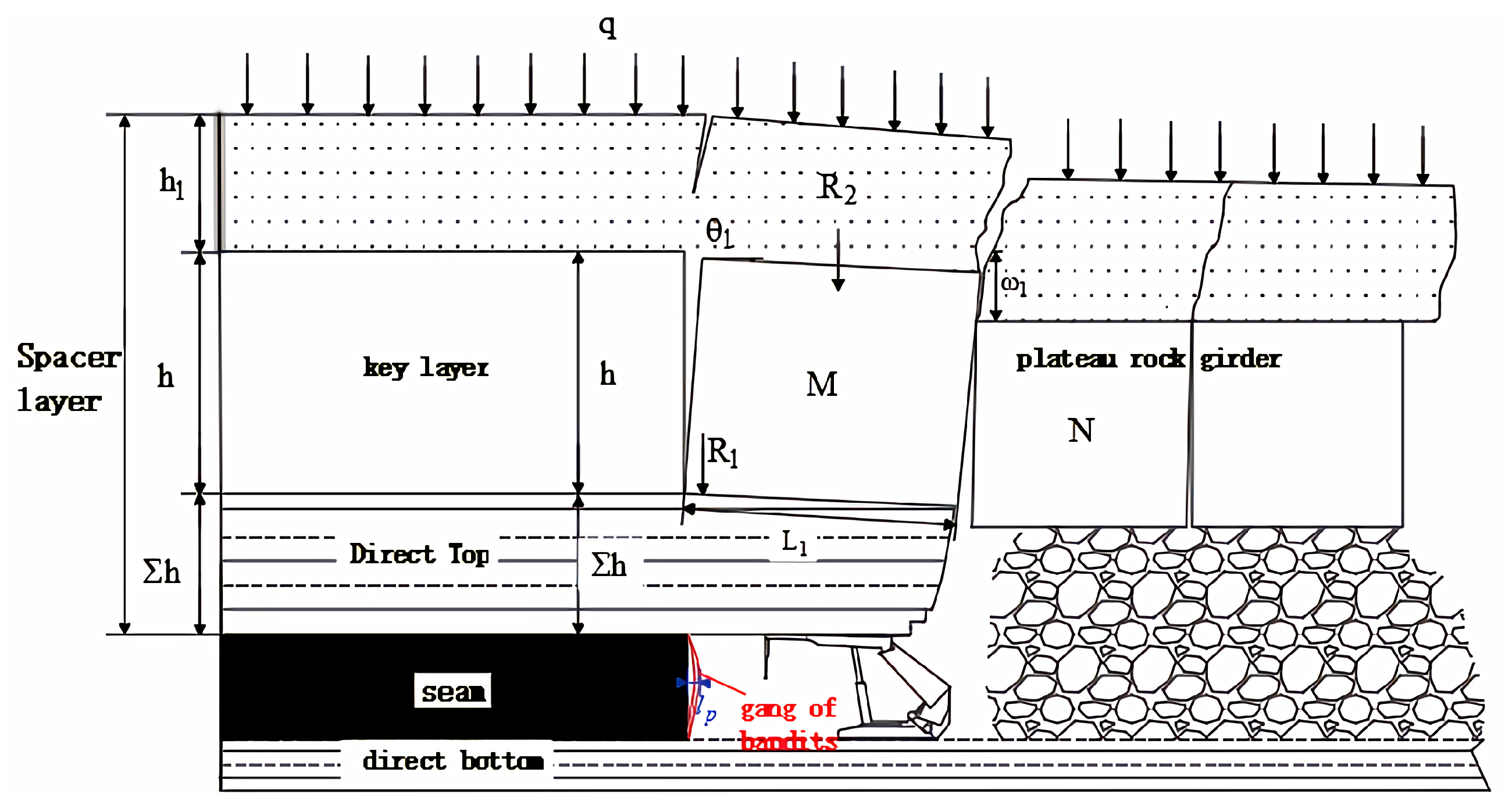
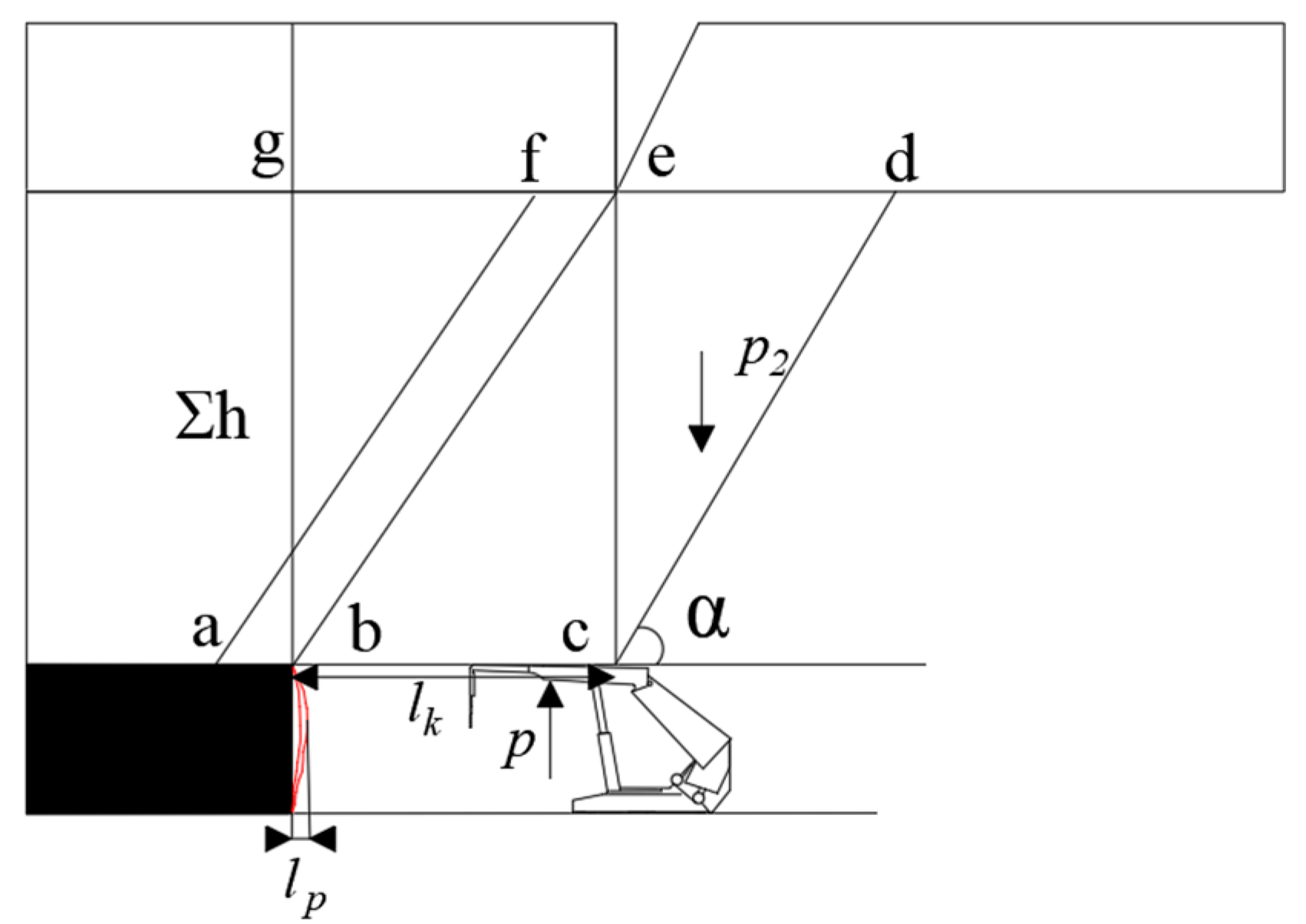
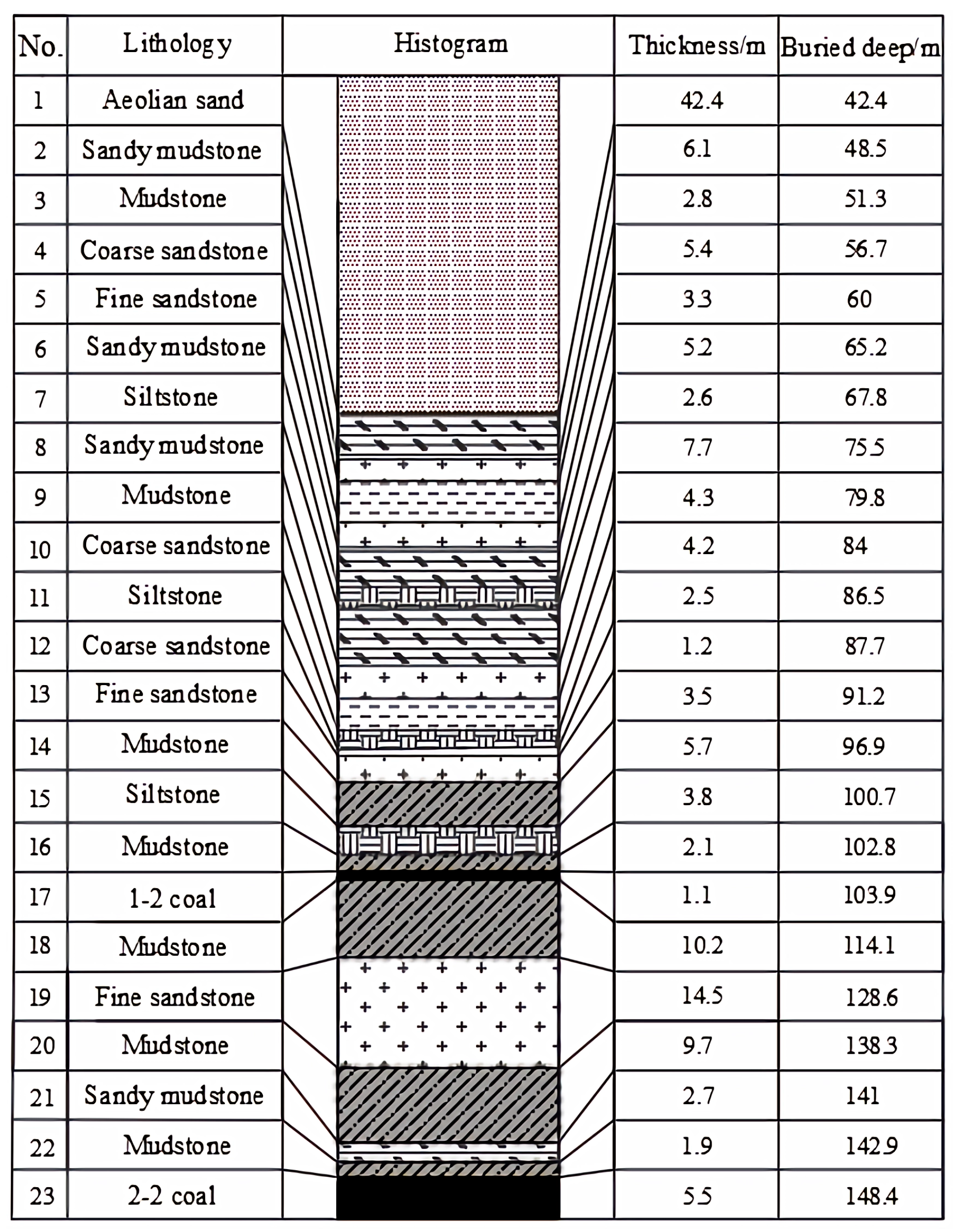
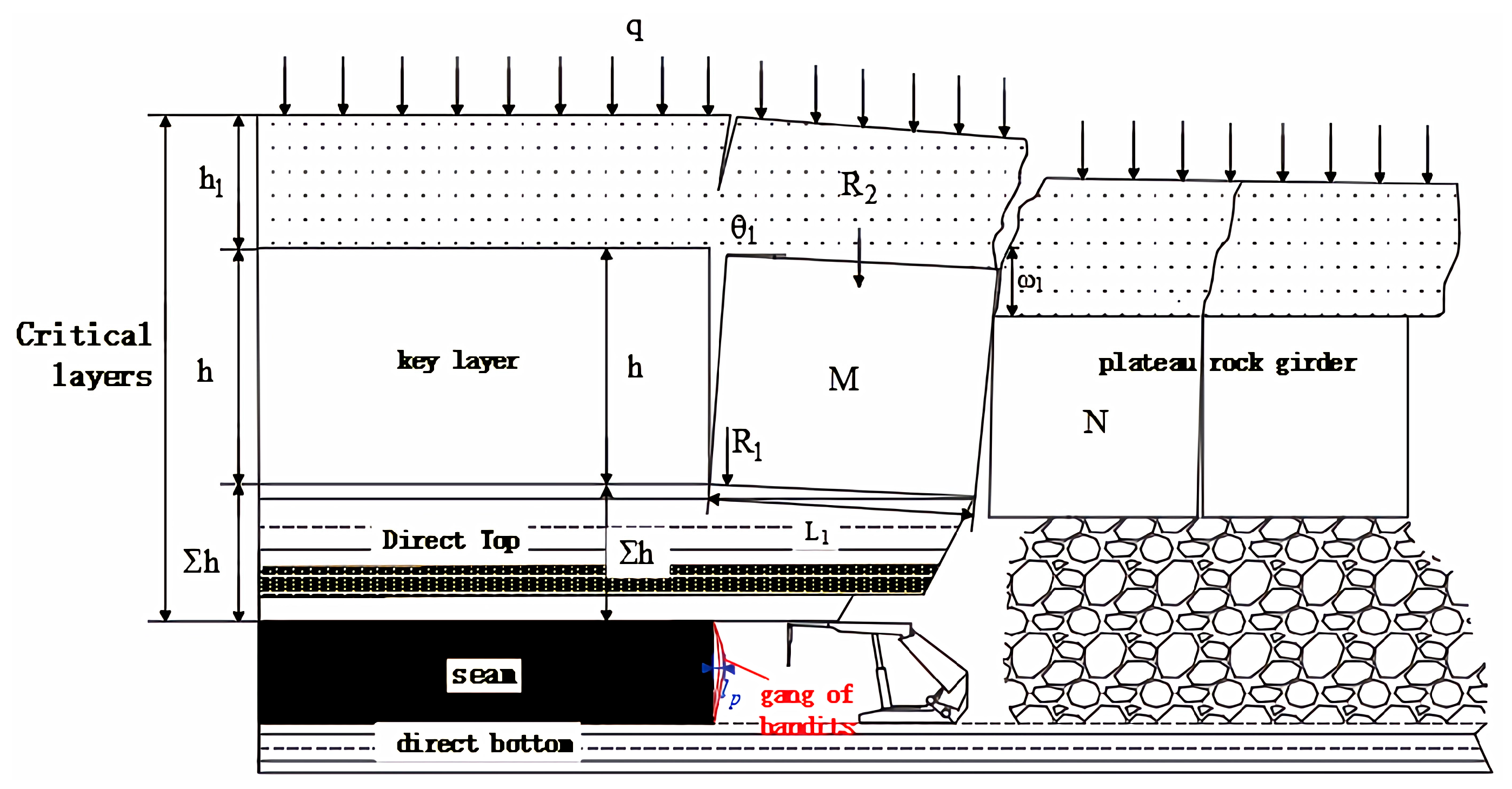
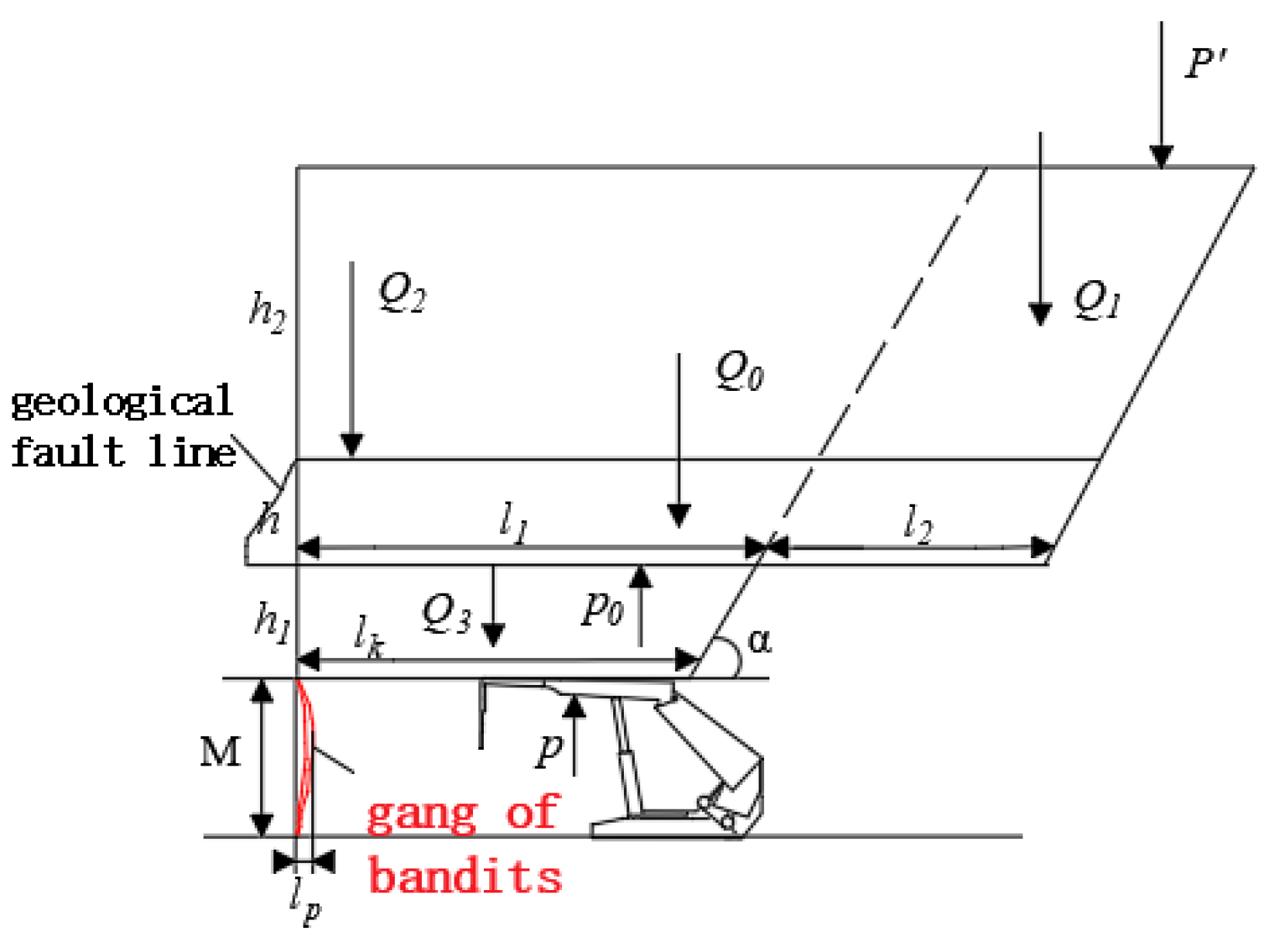
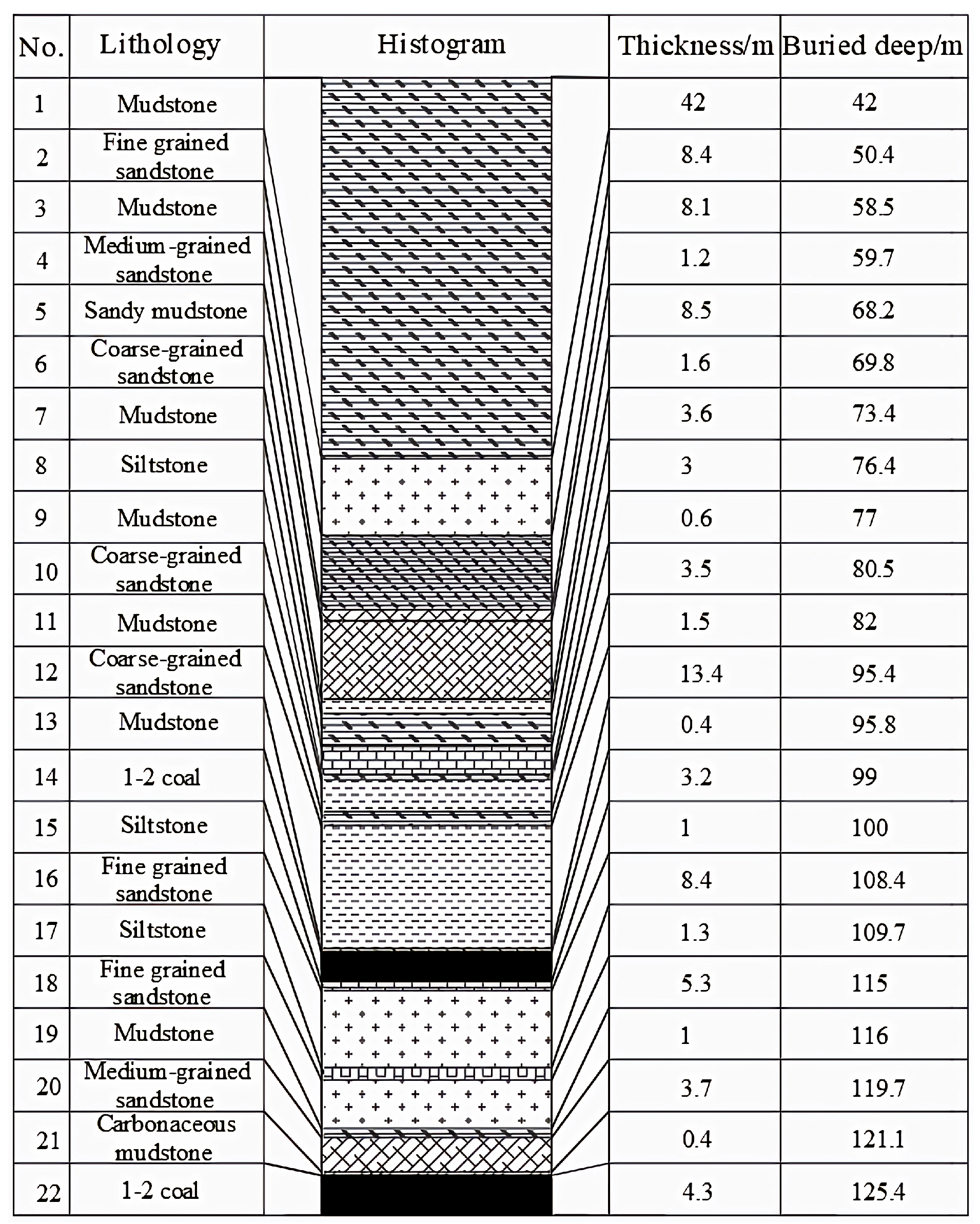




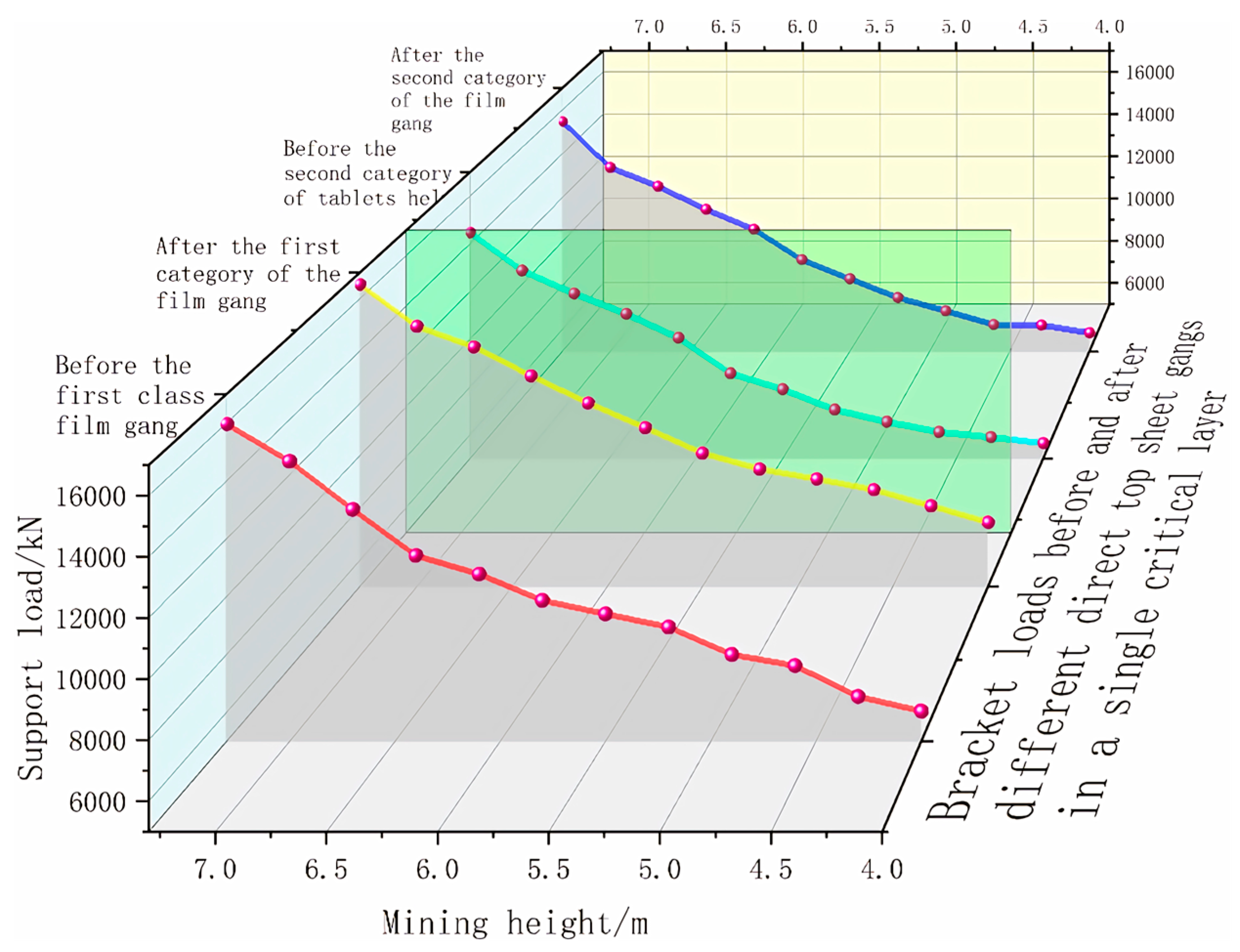

Disclaimer/Publisher’s Note: The statements, opinions and data contained in all publications are solely those of the individual author(s) and contributor(s) and not of MDPI and/or the editor(s). MDPI and/or the editor(s) disclaim responsibility for any injury to people or property resulting from any ideas, methods, instructions or products referred to in the content. |
© 2025 by the authors. Licensee MDPI, Basel, Switzerland. This article is an open access article distributed under the terms and conditions of the Creative Commons Attribution (CC BY) license (https://creativecommons.org/licenses/by/4.0/).
Share and Cite
Zhang, P.; Chen, Y.; Wei, Y.; Li, Z.; Dong, L. Research on Overburdened Rock Structures and Support Resistance of Shallow Buried Large Mining Heights Based on Sheet Gangs. Appl. Sci. 2025, 15, 4730. https://doi.org/10.3390/app15094730
Zhang P, Chen Y, Wei Y, Li Z, Dong L. Research on Overburdened Rock Structures and Support Resistance of Shallow Buried Large Mining Heights Based on Sheet Gangs. Applied Sciences. 2025; 15(9):4730. https://doi.org/10.3390/app15094730
Chicago/Turabian StyleZhang, Pei, Yang Chen, Yibo Wei, Zhuo Li, and Liqiang Dong. 2025. "Research on Overburdened Rock Structures and Support Resistance of Shallow Buried Large Mining Heights Based on Sheet Gangs" Applied Sciences 15, no. 9: 4730. https://doi.org/10.3390/app15094730
APA StyleZhang, P., Chen, Y., Wei, Y., Li, Z., & Dong, L. (2025). Research on Overburdened Rock Structures and Support Resistance of Shallow Buried Large Mining Heights Based on Sheet Gangs. Applied Sciences, 15(9), 4730. https://doi.org/10.3390/app15094730





